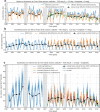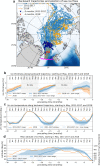Unprecedented decline of Arctic sea ice outflow in 2018
- PMID: 35365660
- PMCID: PMC8975830
- DOI: 10.1038/s41467-022-29470-7
Unprecedented decline of Arctic sea ice outflow in 2018
Abstract
Fram Strait is the major gateway connecting the Arctic Ocean and North Atlantic Ocean, where nearly 90% of the sea ice export from the Arctic Ocean takes place. The exported sea ice is a large source of freshwater to the Nordic Seas and Subpolar North Atlantic, thereby preconditioning European climate and deep water formation in the North Atlantic Ocean. Here we show that in 2018, the ice export through Fram Strait showed an unprecedented decline since the early 1990s. The 2018 ice export was reduced to less than 40% relative to that between 2000 and 2017. The minimum export is attributed to regional sea ice-ocean processes driven by an anomalous atmospheric circulation over the Atlantic sector of the Arctic. The result indicates that a drastic change of the Arctic sea ice outflow and its environmental consequences happen not only through Arctic-wide ice thinning, but also by regional scale atmospheric anomalies.
© 2022. The Author(s).
Conflict of interest statement
The authors declare no competing interests.
Figures





References
-
- Peterson BJ, et al. Trajectory shifts in the Arctic and subarctic freshwater cycle. Science. 2006;313:1061–1066. - PubMed
-
- Carmack EC, et al. Freshwater and its role in the Arctic Marine System: sources, disposition, storage, export, and physical and biogeochemical consequences in the Arctic and global oceans. J. Geophys. Res. Biogeosci. 2015;121(3):675–717.
-
- Dai A, Trenberth KE. Estimates of freshwater discharge from continents: latitudinal and seasonal variations. J. Hydrometeorol. 2002;3:660–687.
-
- Greene CH, Pershing PJ. Climate drives sea change. Science. 2007;315:1084–1085. - PubMed
Publication types
MeSH terms
LinkOut - more resources
Full Text Sources

